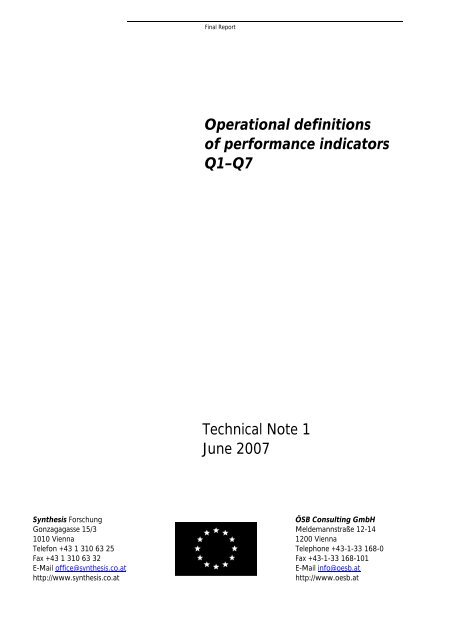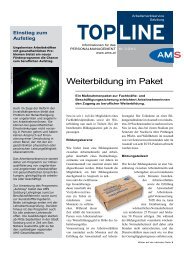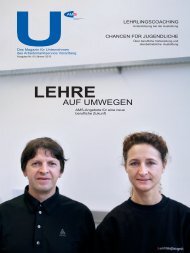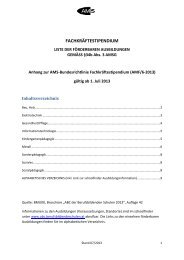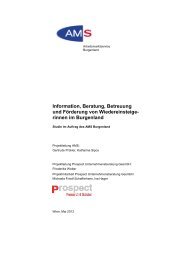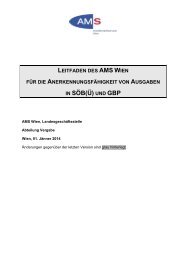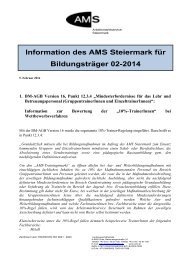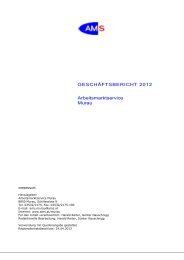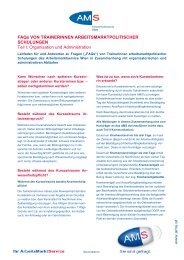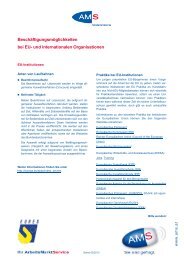Operational definitions of performance indicators Q1-;Q7 Technical ...
Operational definitions of performance indicators Q1-;Q7 Technical ...
Operational definitions of performance indicators Q1-;Q7 Technical ...
You also want an ePaper? Increase the reach of your titles
YUMPU automatically turns print PDFs into web optimized ePapers that Google loves.
Synthesis Forschung<br />
Gonzagagasse 15/3<br />
1010 Vienna<br />
Telefon +43 1 310 63 25<br />
Fax +43 1 310 63 32<br />
E-Mail <strong>of</strong>fice@synthesis.co.at<br />
http://www.synthesis.co.at<br />
Final Report<br />
<strong>Operational</strong> <strong>definitions</strong><br />
<strong>of</strong> <strong>performance</strong> <strong>indicators</strong><br />
<strong>Q1</strong>–<strong>Q7</strong><br />
<strong>Technical</strong> Note 1<br />
June 2007<br />
ÖSB Consulting GmbH<br />
Meldemannstraße 12-14<br />
1200 Vienna<br />
Telephone +43-1-33 168-0<br />
Fax +43-1-33 168-101<br />
E-Mail info@oesb.at<br />
http://www.oesb.at
Preface<br />
Preface<br />
In fall 2004, the Austrian Public Employment Service<br />
»AMS« took the initiative to start the second stage<br />
<strong>of</strong> the project »Mutual learning - Benchmarking among<br />
Public Employment Services«. A Working Group was set up.<br />
It extended invitations to join the Working Group to all<br />
Member States.<br />
Thirteen Participating Partners were involved in the Working<br />
Group:<br />
• Arbeitsmarktservice AMS – Austria<br />
• Arbetsmarknadsstyrelsen AMS – Sweden<br />
• Office Régional Bruxellois de’l Emploi ORBEM-BGDA –<br />
Belgium/Brussels<br />
• Vlaamse Dienst voor Arbeidsbemiddeling en<br />
Beroepsopleiding VDAB – Belgium/Flanders<br />
• Ministry <strong>of</strong> Labour – Finland<br />
• Agence Nationale Pour l’Emploi ANPE – France<br />
• Bundesagentur für Arbeit – Germany<br />
• Foras Áiseanna Saothair FÁS – Ireland<br />
• State Employment Agency NVA – Latvia<br />
• Centrale Organisatie Werk en Inkomen CWI – The<br />
Netherlands<br />
• Central Office <strong>of</strong> Labour – Slovakia<br />
• Employment Service <strong>of</strong> Slovenia ESS – Slovenia<br />
• Jobcentre Plus – United Kingdom<br />
The Working Group has received financial support from the<br />
European Commission »DG Employment and Social Affairs«.<br />
Once established, the Working Group set itself four tasks:<br />
– to draw up a list <strong>of</strong> selected <strong>performance</strong> <strong>indicators</strong><br />
– to build a data base for those <strong>indicators</strong><br />
– to establish a benchmarking procedure bearing the<br />
different contexts in mind under which the public<br />
employment services operate<br />
– to organize an exchange <strong>of</strong> good practices.<br />
In order to achieve its ambitious tasks, the Participating<br />
Partners asked the Austrian AMS to assume the responsibility<br />
<strong>of</strong> project leader and secretariat for the Working Group.
Preface<br />
The project leader, AMS Austria, regularly consulted a Coordination<br />
Group in which the representatives <strong>of</strong> VDAB<br />
Flanders, CWI The Netherlands and ESS Slovenia <strong>of</strong>fered<br />
their advice.<br />
A group <strong>of</strong> consultants (ÖSB Consulting and Synthesis<br />
Research) was selected (on the basis <strong>of</strong> a tender) to prepare<br />
the decisions taken by the Participating Partners and to<br />
document the results achieved.<br />
The following report should be considered as such a<br />
document.<br />
The operational <strong>definitions</strong> <strong>of</strong> the PES <strong>performance</strong><br />
<strong>indicators</strong> <strong>Q1</strong>–<strong>Q7</strong> have been agreed upon by the Participating<br />
Partners at their meetings in Vienna. The paper<br />
presents the conclusions the team <strong>of</strong> consultants has drawn<br />
from the discussion during the meetings in March and June<br />
2006.<br />
Some Participating Partners have asked that the figures<br />
forwarded (and thus the benchmarking results) should be<br />
treated with some confidentiality. They felt that this<br />
requirement is to some extent already met when the<br />
Participating Partners are identified by letters <strong>of</strong> the alphabet<br />
rather than by their proper names. There exist, <strong>of</strong> course,<br />
versions <strong>of</strong> the data base where the Participating Partners<br />
are fully identified.<br />
This report might be subject to revision. Comments and<br />
suggestions are welcome.<br />
For the team <strong>of</strong> consultants:<br />
Pr<strong>of</strong>. Michael Wagner-Pinter<br />
Vienna, June 2007
Overview<br />
Reports<br />
<strong>Technical</strong> Notes<br />
Background<br />
Information<br />
Copyright<br />
Preface<br />
Structure <strong>of</strong> the final report<br />
The final report is organized in a modular way. It consists <strong>of</strong><br />
several reports. Each report addresses itself to a specific<br />
audience:<br />
• PES-Performance: Benchmarking and Good Practice<br />
(This »Overview« addresses readers who take a general<br />
interest in the project)<br />
• Report 1:<br />
Benchmarking <strong>of</strong> PES Performance Indicators 2004<br />
• Report 2:<br />
Benchmarking <strong>of</strong> PES Performance Indicators 2005<br />
• Report 3:<br />
Selected Good Practices<br />
(Reports 1 to 3 address the Participating Partners and<br />
the European Commission)<br />
• <strong>Technical</strong> Note 1:<br />
<strong>Operational</strong> definition <strong>of</strong> <strong>performance</strong> <strong>indicators</strong><br />
• <strong>Technical</strong> Note 2:<br />
Measurement procedures<br />
(<strong>Technical</strong> Notes 1 to 2 address specialists (working with the<br />
Participating Partners or the European Commission) who<br />
wish to gain detailed insight into the procedures applied)<br />
• PES Background and Content Information<br />
(2005)<br />
(The »PES Background and Content Information« documents<br />
the scope and scale <strong>of</strong> activities <strong>of</strong> the participating PES)<br />
It should be noted that the Participating Partners reserve<br />
the copyright on the numerical information they have<br />
forwarded for benchmarking purposes. Whoever wishes<br />
to make public use <strong>of</strong> these data is asked to contact the<br />
project leader (AMS Austria) or the respective Participating<br />
Partners.
Content<br />
1<br />
<strong>Operational</strong> defintions <strong>of</strong> <strong>performance</strong> <strong>indicators</strong> <strong>Q1</strong> to Q3 6<br />
1.1 List <strong>of</strong> concepts and terms <strong>of</strong> <strong>indicators</strong> <strong>Q1</strong> to Q3 7<br />
1.2 List <strong>of</strong> <strong>indicators</strong> <strong>Q1</strong> to Q3 8<br />
1.3 <strong>Operational</strong> <strong>definitions</strong> <strong>of</strong> eight populations<br />
for <strong>indicators</strong> <strong>Q1</strong> to Q3 9<br />
1.4 Deriving indicator values 12<br />
1.5 Clarification <strong>of</strong> measurement procedure 13<br />
2<br />
<strong>Operational</strong> defintions <strong>of</strong> <strong>performance</strong> <strong>indicators</strong> Q4 and Q5 16<br />
2.1 List <strong>of</strong> concepts and terms <strong>of</strong> <strong>indicators</strong> Q4 and Q5 17<br />
2.2 List <strong>of</strong> <strong>indicators</strong> Q4 and Q5 17<br />
2.3 <strong>Operational</strong> <strong>definitions</strong> <strong>of</strong> seven populations for<br />
<strong>indicators</strong> Q4 and Q5 18<br />
2.4 Deriving indicator values 20<br />
2.5 Clarification <strong>of</strong> measurement procedure 21<br />
3<br />
<strong>Operational</strong> defintions <strong>of</strong> <strong>performance</strong> <strong>indicators</strong> Q6 and <strong>Q7</strong> 23<br />
3.1 »Satisfaction« <strong>indicators</strong> Q6 and <strong>Q7</strong> 24<br />
Appendix<br />
Annex A1: List <strong>of</strong> Participating Partners 27<br />
Imprint 29
<strong>Operational</strong> <strong>definitions</strong> <strong>of</strong> <strong>performance</strong> <strong>indicators</strong> <strong>Q1</strong>–<strong>Q7</strong><br />
1<br />
<strong>Operational</strong> defintions <strong>of</strong><br />
<strong>performance</strong> <strong>indicators</strong> <strong>Q1</strong> to Q3<br />
1.1 List <strong>of</strong> concepts and terms <strong>of</strong> <strong>indicators</strong> <strong>Q1</strong> to Q3 7<br />
1.2 List <strong>of</strong> <strong>indicators</strong> <strong>Q1</strong> to Q3 8<br />
1.3 <strong>Operational</strong> <strong>definitions</strong> <strong>of</strong> eight populations<br />
for <strong>indicators</strong> <strong>Q1</strong> to Q3 9<br />
1.4 Deriving indicator values 12<br />
1.5 Clarification <strong>of</strong> measurement procedure 13<br />
6
1<br />
1.1<br />
List <strong>of</strong> concepts and terms <strong>of</strong> <strong>indicators</strong><br />
1 <strong>Operational</strong> defintions <strong>of</strong> <strong>performance</strong> <strong>indicators</strong> <strong>Q1</strong>–Q3<br />
– Transition from unemployment (<strong>Q1</strong>)<br />
– Transition to employment before unemployment<br />
lasts long (Q2)<br />
– Transition from training measures to employment<br />
(Q3)<br />
Concepts /Terms Meanings<br />
T 1 PES-registration <strong>of</strong> a person T 1.0 The PES puts the name <strong>of</strong> a person on<br />
to a register<br />
T 2 (PES-)Deregistration T 2.0 The PES deletes the name from a<br />
register (it might keep the name in its<br />
information system)<br />
T 3 Unemployed job seeker T 3.0 This is a person on the PES-register<br />
willing to accept a job<br />
Option 1: T 3.1 including participants in training<br />
measures<br />
Option 2: T 3.2 excluding participants in training<br />
measures<br />
T 4 Employment (considered as<br />
opposite to unemployment)<br />
7<br />
T 4.0 All kinds <strong>of</strong> jobs, if their acceptance<br />
implies PES-deregistration as<br />
unemployed job seeker<br />
T 5 Training measure T 5.0 Consult the paper: Labour Market<br />
Policy Database: Methodology. Revision<br />
<strong>of</strong> June 2006. page 14 ff §§ 52-64.<br />
EUROSTAT 2006<br />
T 6 Participating in training measures T 6.0 A person takes part in training<br />
measures for which the PES is<br />
accountable (e.g. the PES provides the<br />
financial funds for the measures)<br />
T 7 Transition to employment T 7.0<br />
Option 1: T 7.1<br />
Option 2: T 7.2<br />
Option 3: T 7.3<br />
A person is deregistered<br />
and is employed (for at least one day)<br />
during the six months following<br />
deregistration<br />
and is not reregistered as unemployed<br />
job seeker within eight weeks under<br />
circumstances which suggest that<br />
people have a strong incentive to<br />
register if they are not in employment<br />
and the deregistration is coded by the<br />
PES »for reasons <strong>of</strong> employment«
1.2<br />
List <strong>of</strong> <strong>indicators</strong> <strong>Q1</strong> to Q3<br />
1 <strong>Operational</strong> defintions <strong>of</strong> <strong>performance</strong> <strong>indicators</strong> <strong>Q1</strong>–Q3<br />
NR Concept Basic measurement approach<br />
<strong>Q1</strong> Transition to employment <strong>of</strong> the<br />
unemployed<br />
Q2 Transition to employment before<br />
unemployment lasts too long<br />
Q3 Transition from training measures to<br />
employment<br />
8<br />
N: Transition to employment (within six months) <strong>of</strong><br />
registered persons<br />
D: People on the register (for some time) during a<br />
specific month<br />
N: Transition to employment (within six months) <strong>of</strong><br />
those who deregister with a spell duration <strong>of</strong> less than<br />
six months<br />
D: People who are deregistered with a spell duration <strong>of</strong><br />
less than six months during a specific month<br />
N: Transition to employment (within six months) <strong>of</strong><br />
those who terminate a training measure<br />
D: People who terminate a training measures during a<br />
specific month
1 <strong>Operational</strong> defintions <strong>of</strong> <strong>performance</strong> <strong>indicators</strong> <strong>Q1</strong>–Q3<br />
1.3<br />
<strong>Operational</strong> <strong>definitions</strong> <strong>of</strong> eight populations for <strong>indicators</strong> <strong>Q1</strong> to Q3<br />
POP1 POPULATION 1 (on the PES register as unemployed job seekers)<br />
(1) Count the individuals<br />
(2) who are on a PES register<br />
(3) (at least some time) during the month Mi and<br />
(4) who are unemployed (and)<br />
(5) who are job seeking.<br />
(6) This number is denoted by (POP1)i.<br />
POP2 POPULATION 2 (participation in training measures)<br />
(7) Count the individuals<br />
(8) who are participating in training measures<br />
(9) for which the PES is accountable<br />
(10) (at least some time) during the month Mi.<br />
(11) This number is denoted by (POP2)i.<br />
POP3 POPULATION 3 (deregistration <strong>of</strong> unemployed job seekers)<br />
(12) Count the individuals<br />
(13) with the characteristics (2), (3), (4), and (5)<br />
(14) who had been deregistered<br />
(15) during month Mi.<br />
(16) This number is denoted by (POP3)i.<br />
9
1 <strong>Operational</strong> defintions <strong>of</strong> <strong>performance</strong> <strong>indicators</strong> <strong>Q1</strong>–Q3<br />
POP4 POPULATION 4 (deregistration <strong>of</strong> unemployed job seekers<br />
with a spell duration <strong>of</strong> less than six months)<br />
(17) Count the individuals<br />
(18) with the characteristics (13), (14) and (15)<br />
(19) who had been registered for less than six months (spell duration).<br />
(20) This number is denoted by (POP4)i.<br />
POP5 POPULATION 5 (terminating training measures)<br />
(21) Count the individuals<br />
(22) with the characteristics (8), (9) and (10)<br />
(23) who had terminated the participation in training measures<br />
(24) during month Mi.<br />
(25) This number is denoted by (POP5)i.<br />
POP6 POPULATION 6 (deregistration and transition to employment)<br />
(26) Count the individuals<br />
(27) with the characteristics (13), (14) and (15)<br />
(28) who made a transition to employment (within six months after deregistering).<br />
(29) This number is denoted by (POP6)i.<br />
POP7 POPULATION 7 (deregistration <strong>of</strong> unemployed job seeker<br />
before the six months mark and transition to employment)<br />
(30) Count the individuals<br />
(31) with the characteristics (18) and (19) and<br />
(32) with the characteristic (28).<br />
(33) This number is denoted by (POP7)i.<br />
10
1 <strong>Operational</strong> defintions <strong>of</strong> <strong>performance</strong> <strong>indicators</strong> <strong>Q1</strong>–Q3<br />
POP8 POPULATION 8 (terminating training measures and transition to employment)<br />
(34) Count the individuals<br />
(35) with the characteristics (22), (23) and (24) (and)<br />
(36) with the characteristic (28).<br />
(37) This number is denoted by (POP8)i.<br />
11
1<br />
If it is too difficult or<br />
too costly to retrieve information<br />
for each <strong>of</strong> the 12<br />
months, it is worthwhile<br />
to consider procedures<br />
which approximate the<br />
algorithm.<br />
1.4<br />
Deriving indicator values<br />
From one to<br />
twelve months<br />
<strong>Q1</strong>, Q2 and Q3<br />
From unemployment<br />
to employment<br />
Transition to<br />
employment before<br />
unemployment lasts<br />
long<br />
From measures<br />
to employment<br />
Best case, worst case<br />
1 <strong>Operational</strong> defintions <strong>of</strong> <strong>performance</strong> <strong>indicators</strong> <strong>Q1</strong>–Q3<br />
The first step is to calculate the values for (POP1)i, (POP2)i,<br />
(POP3)i, (POP4)i, (POP5)i, (POP6)i, (POP7)i, (POP8)i, where i<br />
runs from month 1 to 12 for the year for which the POPvalues<br />
are to be reported 1<br />
. A single month will most likely<br />
not do, because <strong>of</strong> strong seasonal biases.<br />
Once values for POP1, POP2, POP3, POP4, POP5, POP6,<br />
POP7, POP8 have been calculated, it is straightforward to<br />
arrive at values for the three transition <strong>indicators</strong>.<br />
<strong>Q1</strong> = POP6 divided by POP1<br />
Q2 = POP7 divided by POP4<br />
Q3 = POP8 divided by POP5<br />
where <strong>Q1</strong>, Q2, Q3 are not smaller than 0 and not larger<br />
than 1.<br />
<strong>Q1</strong> gives the figure for those people who have made a<br />
transition to employment (within six months) after<br />
deregistration as a share <strong>of</strong> all people on the register for<br />
unemployed job seekers.<br />
Q2 gives the figure for those people who have made the<br />
transition to employment (within six months after<br />
deregistration) after having been on the register for less than<br />
six months as a share <strong>of</strong> all people who have left the register<br />
(after having been on the register for less than six months).<br />
Q3 gives the figure for those people who have made the<br />
transition to employment (within six months after<br />
deregistration) after having terminated a training measure as<br />
a share <strong>of</strong> all people having terminated a training measure.<br />
If <strong>Q1</strong>, Q2, Q3 assume the value 1, then all <strong>of</strong> the job seekers<br />
made the transition; if <strong>Q1</strong>, Q2 assume the value 0, then<br />
none <strong>of</strong> the job seekers made the transition.<br />
12
1.5<br />
Clarification <strong>of</strong> measurement procedure<br />
POP 1: Number <strong>of</strong><br />
individuals registered<br />
as unemployed<br />
job seekers<br />
POP 2: Number <strong>of</strong><br />
individuals<br />
participating in training<br />
measures<br />
POP 3: Number <strong>of</strong><br />
individuals<br />
deregistering<br />
POP 4: Number <strong>of</strong><br />
individuals<br />
deregistering with a<br />
spell duration <strong>of</strong> less<br />
than six months<br />
1 <strong>Operational</strong> defintions <strong>of</strong> <strong>performance</strong> <strong>indicators</strong> <strong>Q1</strong>–Q3<br />
Option 1: Number <strong>of</strong> individuals at the end <strong>of</strong> month Mi-1<br />
(or number <strong>of</strong> individuals at the beginning <strong>of</strong> month Mi) plus<br />
inflow during month Mi<br />
Option 2: Number <strong>of</strong> individuals at the end (or at the<br />
beginning) <strong>of</strong> month Mi<br />
Option 3: Average monthly stock <strong>of</strong> month Mi<br />
Option 1: Number <strong>of</strong> individuals in training measures at the<br />
end <strong>of</strong> month Mi-1 (or number <strong>of</strong> individuals in training<br />
measures at the beginning <strong>of</strong> month Mi) plus inflow during<br />
month Mi<br />
Option 2: Number <strong>of</strong> individuals in training measures at the<br />
end (or at the beginning) <strong>of</strong> month Mi<br />
Option 3: Average monthly stock <strong>of</strong> individuals in training<br />
measures in month Mi<br />
Please apply the EUROSTAT explanation <strong>of</strong> TRAINING<br />
measures in: Labour Market Policy Database Methodology.<br />
Revision <strong>of</strong> June 2006. page 14 ff §§ 52-64<br />
Training measures include: Institutional training, workplace<br />
training, alternate training and special support for<br />
apprenticeship<br />
Number <strong>of</strong> job seekers registered as unemployed in the<br />
month(s) preceding month Mi who are leaving the register<br />
during month Mi (to make a transition either to employment<br />
or out <strong>of</strong> labour force)<br />
Please note: In some PES people do not get deregistered as<br />
unemployed, if they hold a (part time) job; thus these people<br />
are not "deregistered"<br />
Number <strong>of</strong> job seekers registered as unemployed in the<br />
month(s) preceding month Mi who are leaving the register<br />
during month Mi with a spell duration <strong>of</strong> less than six<br />
months (to make a transition either to employment or out <strong>of</strong><br />
labour force)<br />
Please note: In some PES people do not get deregistered as<br />
unemployed, if they hold a (part time) job; thus these people<br />
are not "deregistered"<br />
13
POP 5: Number <strong>of</strong><br />
individuals terminating<br />
training measures<br />
POP 6: Deregistration<br />
and transition to<br />
employment<br />
POP 7: Deregistration<br />
before the six months<br />
mark and transition to<br />
employment<br />
1 <strong>Operational</strong> defintions <strong>of</strong> <strong>performance</strong> <strong>indicators</strong> <strong>Q1</strong>–Q3<br />
Number <strong>of</strong> people who are leaving training measures in<br />
month Mi (which does not imply that they leave the<br />
unemployment register) in case they are registered while<br />
participating in measures<br />
Number <strong>of</strong> job seekers registered as unemployed in the<br />
month(s) preceding month Mi who are leaving the register<br />
during month Mi to make a transition to employment<br />
(within six months after deregistration)<br />
Please note: Different PES have different notions <strong>of</strong><br />
"employment". It is the specific notion that should serve<br />
as criterion. Indicate whether "employment" includes the<br />
following<br />
- subsidized employment<br />
- self employment<br />
- mini jobs<br />
- part time jobs<br />
Some PES cannot "observe" the transition to employment.<br />
If this is the case, estimates have to be provided (from<br />
secondary statistical sources, like surveys)<br />
Number <strong>of</strong> job seekers registered as unemployed in the<br />
month(s) preceding month Mi who are leaving the register<br />
during month Mi with a spell duration <strong>of</strong> less than six<br />
months to make a transition to employment (within six<br />
months after deregistration)<br />
Please note: Different PES have different notions <strong>of</strong><br />
"employment". It is the specific notion that should serve<br />
as criterion. Indicate whether "employment" includes the<br />
following<br />
- subsidized employment<br />
- self employment<br />
- mini jobs<br />
- part time jobs<br />
Some PES cannot "observe" the transition to employment.<br />
If this is the case, estimates have to be provided (from<br />
secondary statistical sources, like surveys)<br />
14
POP 8: Terminating<br />
training measures and<br />
transition to<br />
employment<br />
1 <strong>Operational</strong> defintions <strong>of</strong> <strong>performance</strong> <strong>indicators</strong> <strong>Q1</strong>–Q3<br />
Number <strong>of</strong> people who are leaving training measures and<br />
the register in month Mi to make a transition to employment<br />
(within six months after deregistration)<br />
Please note: Different PES have different notions <strong>of</strong><br />
"employment". It is the specific notion that should serve<br />
as criterion. Indicate whether "employment" includes the<br />
following<br />
- subsidized employment<br />
- self employment<br />
- mini jobs<br />
- part time jobs<br />
Some PES cannot "observe" the transition to employment.<br />
If this is the case, estimates have to be provided (from<br />
secondary statistical sources, like surveys)<br />
15
<strong>Operational</strong> <strong>definitions</strong> <strong>of</strong> <strong>performance</strong> <strong>indicators</strong> <strong>Q1</strong>–<strong>Q7</strong><br />
2<br />
<strong>Operational</strong> defintions <strong>of</strong><br />
<strong>performance</strong> <strong>indicators</strong> Q4 and Q5<br />
2.1 List <strong>of</strong> concepts and terms <strong>of</strong> <strong>indicators</strong> Q4 and Q5 17<br />
2.2 List <strong>of</strong> <strong>indicators</strong> Q4 and Q5 17<br />
2.3 <strong>Operational</strong> <strong>definitions</strong> <strong>of</strong> seven populations for<br />
<strong>indicators</strong> Q4 and Q5 18<br />
2.4 Deriving indicator values 20<br />
2.5 Clarification <strong>of</strong> measurement procedure 21<br />
16
2 <strong>Operational</strong> defintions <strong>of</strong> <strong>performance</strong> <strong>indicators</strong> Q4 and Q5<br />
2<br />
2.1<br />
List <strong>of</strong> concepts and terms <strong>of</strong> <strong>indicators</strong> Q4 and Q5<br />
Concepts /Terms Meanings<br />
T 8 Vacancy T 8.0 An employer looks for candidates<br />
suitable for a specific job <strong>of</strong>fer<br />
T 9 Set <strong>of</strong> vacancies <strong>of</strong> all employers T 9.0 Vacancies that come up at any<br />
employer <strong>of</strong> the economy to<br />
which the PES relates<br />
T 10 ALMP-Vacancy T 10.0 A vacancy that is only created in the<br />
context <strong>of</strong> active labour market<br />
programmes<br />
T 11 Vacancy posted with the PES T 11.0 An employer asks the PES to publish<br />
the vacancy and to provide support in<br />
finding suitable candidates<br />
T 12 Vacancy accessible through the<br />
PES information system<br />
T 13 A vacancy is filled T 13.0<br />
2.2<br />
List <strong>of</strong> <strong>indicators</strong> Q4 and Q5<br />
17<br />
Option 1: T 13.1<br />
Option 2: T 13.2<br />
T 12.0 A vacancy about which a job seeker<br />
can obtain information through media<br />
(e.g. electronic or physical billboards)<br />
provided by the PES<br />
NR Concept Basic measurement approach<br />
Q4 Opening access to a large share <strong>of</strong><br />
vacancies through the PES information<br />
system<br />
Q5 Making sure that posted vacancies are<br />
filled<br />
The employer has found a suitable<br />
candidate<br />
irrespective <strong>of</strong> the channel <strong>of</strong> contact<br />
presented by the PES<br />
N: Vacancies accessible through the PES information<br />
system (period <strong>of</strong> time)<br />
D: Vacancies that employers wish to fill (period <strong>of</strong> time)<br />
N: Vacancies (excluding ALMP vacancies) for which a<br />
candidate was found successfully (option: within<br />
4 weeks)<br />
D: Vacancies posted with the PES (period <strong>of</strong> time)
2 <strong>Operational</strong> defintions <strong>of</strong> <strong>performance</strong> <strong>indicators</strong> Q4 and Q5<br />
2.3<br />
<strong>Operational</strong> <strong>definitions</strong> <strong>of</strong> seven populations for <strong>indicators</strong> Q4 and Q5<br />
VAC1 VACANCY 1 (Economic wide vacancies)<br />
(1) Count (or estimate) the vacancies<br />
(2) <strong>of</strong>fered by all employers (in the economy)<br />
(3) during a month Mi.<br />
(4) This number is denoted by (VAC1)i.<br />
VAC2 VACANCY 2 (PES posted vacancies)<br />
(5) Count the vacancies<br />
(6) posted with the PES<br />
(7) during a month Mi.<br />
(8) This number is denoted by (VAC2)i.<br />
VAC3 VACANCY 3 (accessible vacancies)<br />
(9) Count the vacancies<br />
(10) accessible through PES media (electronic or physical billboards)<br />
(11) for every job searching person<br />
(12) during a month Mi.<br />
(13) This number is denoted by (VAC3)i.<br />
18
VAC4 VACANCY 4 (posted vacancies filled)<br />
(14) Count the vacancies<br />
(15) with the characteristics (6)<br />
(16) which are filled during month Mi.<br />
(17) This number is denoted by (VAC4)i.<br />
VAC5 VACANCY 5 (posted vacancies filled within 4 weeks)<br />
(18) Count the vacancies<br />
(19) with the characteristics (6) and (16)<br />
(20) within 4 weeks following its PES posting.<br />
(21) This number is denoted by (VAC5)i.<br />
VAC6 VACANCY 6 (posted vacancies filled with PES-candidate)<br />
(22) Count the vacancies<br />
(23) with the characteristics (19)<br />
(24) for which a candidate presented by the PES has been chosen.<br />
(25) This number is denoted by (VAC6)i.<br />
2 <strong>Operational</strong> defintions <strong>of</strong> <strong>performance</strong> <strong>indicators</strong> Q4 and Q5<br />
VAC7 VACANCY 7 (posted vacancies filled with PES-candidate within four weeks)<br />
(26) Count the vacancies<br />
(27) with the characteristics (19), (20) and (24)<br />
(28) for which a candidate presented by the PES has been chosen.<br />
(29) This number is denoted by (VAC7)i.<br />
19
1<br />
If it is too difficult or<br />
too costly to retrieve information<br />
for each <strong>of</strong> the 12<br />
months, it is worthwhile<br />
to consider procedures<br />
which approximate the<br />
algorithm.<br />
2.4<br />
Deriving indicator values<br />
A challenging estimate<br />
From one month to<br />
twelve months<br />
Q4 and Q5<br />
Q4<br />
Q5<br />
Best case, worst case<br />
2 <strong>Operational</strong> defintions <strong>of</strong> <strong>performance</strong> <strong>indicators</strong> Q4 and Q5<br />
The first step is to undertake the estimate for the number <strong>of</strong><br />
vacancies in the economy at large. You might be able to<br />
retrieve the information<br />
– from a »vacancy survey« (EUROSTAT plans to implement<br />
such surveys in all Member States)<br />
– from »academic« labour market research institutes<br />
– from estimates you carry out yourself on the basis <strong>of</strong><br />
statistics on »new employment« contracts (during a<br />
year).<br />
Do not hesitate to contact the team <strong>of</strong> consultants to discuss<br />
the options for such an estimate.<br />
The next step following the estimate <strong>of</strong> (VAC1)i is to<br />
calculate the values for (VAC2)i to (VAC7)i, where i runs<br />
from month 1 to 12 for the year for which the VAC-values<br />
are to be reported 1 . A single month will most likely not do,<br />
because <strong>of</strong> strong seasonal biases.<br />
Once the values for VAC1 and VAC7 are established, it is<br />
straight forward to arrive at values for the two vacancy<br />
<strong>indicators</strong>.<br />
Q4 = VAC3 divided by VAC1<br />
Q5 (Variant 1) = VAC 4 divided by VAC2<br />
Q5 (Variant 2) = VAC 5 divided by VAC2<br />
Q5 (Variant 3) = VAC 6 divided by VAC2<br />
Q5 (Variant 4) = VAC 7 divided by VAC2<br />
where Q4 and Q5 are not smaller than 0 and not larger<br />
than 1.<br />
Q4 gives the figure <strong>of</strong> the vacancies accessible through PES<br />
media as a share <strong>of</strong> all »nation wide« vacancies.<br />
Q5 (in its variants) gives the figure <strong>of</strong> all vacancies filled<br />
– at all/or within 4 weeks<br />
– with any candidate/with a candidate presented by the<br />
PES<br />
as a share <strong>of</strong> all posted vacancies.<br />
If Q5 assumes value1 then all posted vacancies get filled<br />
(within four weeks) with candidates (presented by the PES);<br />
if Q5=0 then none posted vacancy is filled.<br />
20
2.5<br />
Clarification <strong>of</strong> measurement procedure<br />
VAC 1: Economic<br />
wide vacancies<br />
VAC 2: PES<br />
posted vacancies<br />
VAC 3:<br />
Accessible vacancies<br />
VAC 4:<br />
Posted vacancies filled<br />
VAC 5: Posted vacancies<br />
filled within 4 weeks<br />
2 <strong>Operational</strong> defintions <strong>of</strong> <strong>performance</strong> <strong>indicators</strong> Q4 and Q5<br />
There are several ways to arrive at an estimate<br />
Option 1: Relying on the data <strong>of</strong> a "vacancy survey"<br />
Option 2: The annual number <strong>of</strong> new employment-contracts<br />
Please note: With respect to option 2 EUROSTAT provides<br />
Labour Turn Over figures for Member States which can be<br />
used for calculating the number <strong>of</strong> new contracts: The<br />
definition <strong>of</strong> LTO according to EUROSTAT is<br />
LTO = (New employment-contracts + emplyoment contracts<br />
terminated) / average level <strong>of</strong> employment contracts<br />
Thus you can arrive at an estimate <strong>of</strong><br />
New employment-contracts = LTO x average level <strong>of</strong><br />
employment contracts / 2<br />
Option 1: Number <strong>of</strong> posted vacancies at the end <strong>of</strong> month<br />
M1-1 (or number <strong>of</strong> posted vacancies at the beginning <strong>of</strong><br />
month Mi) plus inflow <strong>of</strong> posted vacancies in month Mi<br />
Option 2: Number <strong>of</strong> posted vacancies at the end (or at the<br />
beginning) <strong>of</strong> month Mi<br />
Option 3: Average monthly stock <strong>of</strong> posted vacancies<br />
Option 1: Number <strong>of</strong> posted vacancies accessible through<br />
PES media at the end <strong>of</strong> month M1-1 (or number <strong>of</strong> posted<br />
vacancies accessible through PES media at the beginning <strong>of</strong><br />
month Mi) plus inflow <strong>of</strong> posted vacancies accessible<br />
through PES media in month Mi<br />
Option 2: Number <strong>of</strong> posted vacancies accessible through<br />
PES media at the end (or at the beginning) <strong>of</strong> month Mi<br />
Option 3: Average monthly stock <strong>of</strong> posted vacancies<br />
accessible through PES media<br />
Outflow <strong>of</strong> posted vacancies during month Mi (irrespective<br />
whether the vacancy was filled with a job seeking person or<br />
not) or when the vacancy was posted<br />
Outflow <strong>of</strong> posted vacancies during month Mi within 4<br />
weeks since posting (irrespective whether the vacancy was<br />
filled with a job seeking person or not)<br />
21
VAC 6: Posted vacancies<br />
filled with PES<br />
candidates<br />
VAC 7: Posted vacancies<br />
filled with PES<br />
candidates within four<br />
weeks<br />
2 <strong>Operational</strong> defintions <strong>of</strong> <strong>performance</strong> <strong>indicators</strong> Q4 and Q5<br />
Outflow <strong>of</strong> posted vacancies during month Mi which are<br />
filled by means <strong>of</strong> the PES with a candidate presented by the<br />
PES<br />
Outflow <strong>of</strong> posted vacancies during month Mi within 4<br />
weeks since posting which are filled by means <strong>of</strong> the PES<br />
with a candidate presented by the PES<br />
22
<strong>Operational</strong> <strong>definitions</strong> <strong>of</strong> <strong>performance</strong> <strong>indicators</strong> <strong>Q1</strong>–<strong>Q7</strong><br />
3<br />
Indicators Q6 and <strong>Q7</strong><br />
3.1 »Satisfaction« <strong>indicators</strong> Q6 and <strong>Q7</strong> 24<br />
23
3 Indicators<br />
Q6 and <strong>Q7</strong><br />
3.1<br />
»Satisfaction« <strong>indicators</strong> Q6 and <strong>Q7</strong><br />
Satisfaction <strong>of</strong><br />
job seekers and<br />
employers<br />
Survey is indispensable<br />
Variations in<br />
survey design<br />
»Standard survey«<br />
scenario<br />
<strong>Operational</strong><br />
definition <strong>of</strong> indicator<br />
Best case, worst case<br />
3 <strong>Operational</strong> <strong>definitions</strong> <strong>of</strong> <strong>performance</strong> <strong>indicators</strong> Q6 and <strong>Q7</strong><br />
The two <strong>performance</strong> <strong>indicators</strong> Q6 and <strong>Q7</strong> are from an<br />
operational point <strong>of</strong> view quite the same. Both <strong>indicators</strong><br />
aim at capturing the »satisfaction with the overall service<br />
the PES provides to customers«. Q6 is directed towards<br />
people (as potential job seekers), whereas <strong>Q7</strong> is directed<br />
towards employers.<br />
The empirical information for Q6 and <strong>Q7</strong> has to be survey<br />
based. Thus, the PES either has already established such a<br />
survey (and is therefore in a position to retrieve the<br />
information); or it has not (yet) established the survey and<br />
can therefore not retrieve the information.<br />
Of course, there might be a substantial variation in the way<br />
the survey is carried out (methods <strong>of</strong> sampling, frequency <strong>of</strong><br />
the survey, type <strong>of</strong> questions asked), but this will not be<br />
dealt with at this stage <strong>of</strong> the project.<br />
There are, however, two issues that have to be addressed in<br />
the context <strong>of</strong> operational <strong>definitions</strong>.<br />
Let us start with the following standard scenario for a<br />
»satisfaction survey«. This »standard survey«<br />
• includes the question »How are you satisfied with<br />
the overall services the Public Employment Service has<br />
delivered?«<br />
• structures the answers to the questions into the items<br />
– very satisfied<br />
– satisfied<br />
– unsatisfied<br />
– very unsatisfied<br />
Within the scenario <strong>of</strong> the »standard survey« the operational<br />
<strong>definitions</strong> <strong>of</strong> <strong>indicators</strong> Q6 and <strong>Q7</strong> are straightforward:<br />
(1) Count the number <strong>of</strong> all answers<br />
(2) choosing the items »very satisfied« and »satisfied«.<br />
(3) Divide this number<br />
(4) by the number <strong>of</strong> all answers returned to this question.<br />
The <strong>indicators</strong> will assume the value 1 if all customers are<br />
satisfied; it will assume the value 0 if none is satisfied.<br />
24
Deviations are likely<br />
»Overall satisfaction«<br />
School grading system<br />
3 <strong>Operational</strong> <strong>definitions</strong> <strong>of</strong> <strong>performance</strong> <strong>indicators</strong> Q6 and <strong>Q7</strong><br />
It is likely that the practice <strong>of</strong> several PES among the<br />
Participating Partners will deviate from the »standard<br />
survey« scenario.<br />
In particular, two deviations might occur:<br />
• Firstly, all questions asked refer to specific services<br />
delivered.4<br />
• Secondly, the answers are structured along a grading<br />
which reflects the grading used in the respective<br />
national school system.<br />
Regarding the first deviation, the »overall satisfaction«<br />
can be derived as a weighted average <strong>of</strong> the answers to<br />
the »specific service questions«. The weights used in this<br />
procedure should be documented when the information is<br />
forwarded.<br />
Regarding the second deviation, there is a simple solution.<br />
Just partition the set <strong>of</strong> grades in a »top half« and a<br />
»bottom half« if the number <strong>of</strong> grades is even; if the<br />
number <strong>of</strong> grades is odd, then delete the »neutral grade«<br />
between the »top« and the »bottom« set.<br />
Once this partition has been carried out, it is possible to<br />
use the operational definition given; it is only necessary<br />
to substitute the line (2) by choosing grades from the top<br />
half.<br />
25
Appendix<br />
Annex A1: List <strong>of</strong> Participating Partners 27<br />
Imprint 29<br />
26
Appendix A 1: List <strong>of</strong> Participating Partners<br />
<strong>Operational</strong> <strong>definitions</strong> <strong>of</strong> <strong>performance</strong> <strong>indicators</strong> <strong>Q1</strong>–<strong>Q7</strong><br />
Country Name Tel/Fax/Email Address<br />
Austria Gudrun Nachtschatt Tel: +43-1-33 17 8 521<br />
Fax: +43-1-33 17 8 151<br />
Gudrun.Nachtschatt@ams.at<br />
Austria Peter Oberbichler Tel: +43-1-33 17 8 507<br />
Fax: +43-1-33 17 8 151<br />
Peter.Oberbichler@ams.at<br />
Belgium Orbem Sandy van Rechem Tel: +32-2-505 14 56<br />
Fax: +32- 2-505 78 19<br />
svanrechem@orbem-bgda.be<br />
Belgium VDAB Ludo Jorissen Tel: +32-1-239 09 05<br />
Fax: +32-1-223 40 62<br />
Ludo.jorissen@vdab.be<br />
Finland Ilkka Nio Tel: +35-8-10 60 48 069<br />
Ilkka.Nio@mol.fi<br />
France Danielle Greco Tel: +33-1-49 31 75 40<br />
Germany Britta Lüdeke<br />
Danielle.greco@anpe.fr<br />
Tel: +49-911-179 46 20<br />
Fax: 0049-911-179 1131<br />
Britta.luedeke@arbeitsagentu<br />
r.de<br />
Steffen Sottung Tel: 0049-911-179 21 96<br />
Steffen.sottung@arbeitsagent<br />
ur.de<br />
Ireland Ciaran Sheils Tel: +353 1 6070562<br />
Fax: +353 1 6070605<br />
ciaran.sheils@fas.ie<br />
27<br />
Arbeitsmarktservice Österreich<br />
(AMS)<br />
Treustr. 35-43<br />
A-1200 Wien<br />
Austria<br />
Arbeitsmarktservice Österreich<br />
(AMS)<br />
Treustr. 35-43<br />
A-1200 Wien<br />
Austria<br />
ORBEM-BGDA<br />
Anspachlaan 65<br />
B-1000 Brussels<br />
Belgium<br />
VDAB<br />
Keizlerslaan 11<br />
B-1000 Brüssels<br />
Belgium<br />
Ministry <strong>of</strong> Labour<br />
Policy Department<br />
P.O.BOX 34<br />
FIN-00023 GOVERNMENT<br />
Finland<br />
Agence Nationale Pour l’Emploi<br />
(ANPE)<br />
Direction Générale<br />
4 rue Galilée<br />
93198 Noisy Le Grand<br />
France<br />
Bundesagentur für Arbeit<br />
Regensburger Str. 104<br />
D-90478 Nürnberg<br />
Germany<br />
FÁS<br />
P.O. Box 456<br />
27/33 Upper Baggot Street<br />
Dublin 4<br />
Ireland
Appendix A 1: List <strong>of</strong> Participating Partners<br />
<strong>Operational</strong> <strong>definitions</strong> <strong>of</strong> <strong>performance</strong> <strong>indicators</strong> <strong>Q1</strong>–<strong>Q7</strong><br />
Country Name Tel/Fax/Email Address<br />
Latvia Grieta Tentere Tel: +371 702 17 12<br />
Fax: +371 727 02 53<br />
Grieta.tentere@nva.gov.lv<br />
Netherlands Theo Keulen Tel: +31-20-75 15 066<br />
Fax: +31-20-75 15 084<br />
Theo.Keulen@cwinet.nl<br />
Slovak Republic Bohuslav Beno Tel: +421 2 5328<br />
Fax: +421 2 5729<br />
Bohuslav.beno@upsvar.sk<br />
Slovenia Sonja Pirher<br />
Fax: +386 1 425 98 23<br />
sonja.pirher@ess.gov.si<br />
Sweden Claes-Göran Lock Tel: +46 8 58606042<br />
Claes-<br />
Goran.Lock@ams.amv.se<br />
UK Keith Wheeldon Tel: +44-114-25 94 848<br />
keith.wheeldon@jobcentreplu<br />
s.gsi.gov.uk<br />
28<br />
State Employment Agency<br />
Kr.Valdemra iela 38<br />
Rga, LV-1010<br />
Latvia<br />
CWI<br />
P.O. Box 58191<br />
1040 HD Amsterdam<br />
The Netherlands<br />
Central <strong>of</strong>fice <strong>of</strong> labour, Social<br />
Affairs and Family<br />
Zupne nam. 5 – 6<br />
812 67 Bratislava<br />
Slovakia<br />
Employment Service <strong>of</strong> Slovenia<br />
Glinška Ulica, 12<br />
SI- 1000 Ljubljana<br />
Slovenia<br />
Arbetsmarknadsstyrelsen (AMS)<br />
Vattugatan 17<br />
SE - 11 399 Stockholm<br />
Sweden<br />
JobCentrePlus<br />
Performance Measurement and<br />
Analysis Division<br />
Level 2<br />
Steel City House<br />
Sheffield SI 2GQ<br />
United Kingdom
Imprint<br />
<strong>Operational</strong> <strong>definitions</strong> <strong>of</strong> <strong>performance</strong> <strong>indicators</strong> <strong>Q1</strong>–<strong>Q7</strong><br />
Owner/Publisher:<br />
AMS Austria Bundesgeschäftsstelle<br />
Treustrasse 35-43<br />
1200 Vienna<br />
Austria<br />
Vienna 2007<br />
29


